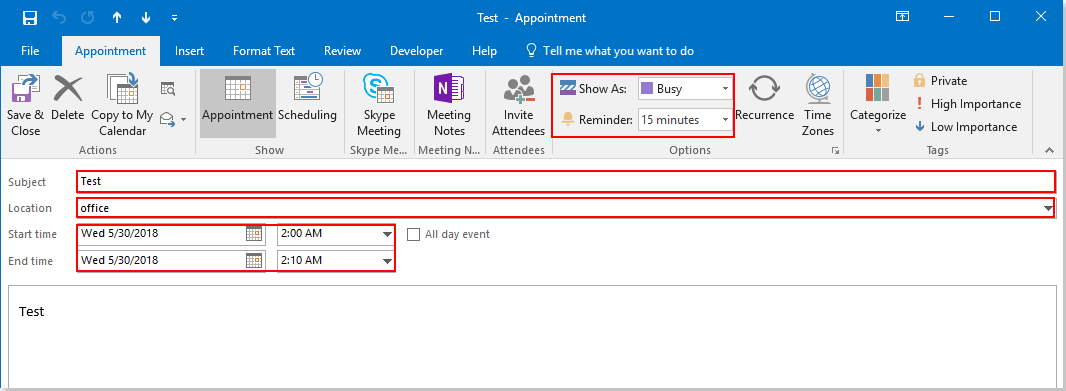Come creare promemoria di Outlook da un foglio di calcolo Excel?
Questo articolo parla della creazione di promemoria di Outlook basati sui dati di un foglio di calcolo Excel.
Crea promemoria di Outlook da un foglio di calcolo Excel con il codice VBA
Crea promemoria di Outlook da un foglio di calcolo Excel con il codice VBA
Se desideri creare promemoria di Outlook da Excel, procedi come segue.
1. Crea un foglio di lavoro contenente le intestazioni di colonna e i campi di promemoria corrispondenti, come mostrato nello screenshot sottostante.

Nota: Per la colonna "stato occupato", il numero "2" significa che il promemoria verrà visualizzato come "Occupato" nel tuo calendario di Outlook. Puoi cambiarlo in "1 (Provvisorio)", "3 (Fuori sede)", "4 (Lavoro altrove)", o "5 (Gratuito)" secondo necessità.
2. Premi i tasti "Alt" + "F11" per aprire la finestra "Microsoft Visual Basic for Applications".
3. Nella finestra "Microsoft Visual Basic for Applications", clicca su "Inserisci" > "Modulo". Dopodiché, copia il seguente codice VBA nella finestra del Codice.
Codice VBA: Crea promemoria di Outlook da un foglio di calcolo Excel
Sub AddAppointments()
'Update by Extendoffice 20180608
Dim I As Long
Dim xRg As Range
Dim xOutApp As Object
Dim xOutItem As Object
Set xOutApp = CreateObject("Outlook.Application")
Set xRg = Range("A2:G2")
For I = 1 To xRg.Rows.Count
Set xOutItem = xOutApp.CreateItem(1)
Debug.Print xRg.Cells(I, 1).Value
xOutItem.Subject = xRg.Cells(I, 1).Value
xOutItem.Location = xRg.Cells(I, 2).Value
xOutItem.Start = xRg.Cells(I, 3).Value
xOutItem.Duration = xRg.Cells(I, 4).Value
If Trim(xRg.Cells(I, 5).Value) = "" Then
xOutItem.BusyStatus = 2
Else
xOutItem.BusyStatus = xRg.Cells(I, 5).Value
End If
If xRg.Cells(I, 6).Value > 0 Then
xOutItem.ReminderSet = True
xOutItem.ReminderMinutesBeforeStart = xRg.Cells(I, 6).Value
Else
xOutItem.ReminderSet = False
End If
xOutItem.Body = xRg.Cells(I, 7).Value
xOutItem.Save
Set xOutItem = Nothing
Next
Set xOutApp = Nothing
End SubNota: Nel codice sopra, "A2:G2" è l'intervallo di dati in base al quale desideri creare gli appuntamenti.
4. Premi "F5" o clicca sul pulsante "Esegui" per eseguire il codice. Dopodiché, tutti gli appuntamenti con campi specifici verranno inseriti nel tuo calendario di Outlook contemporaneamente.
Successivamente, puoi andare al Calendario di Outlook per visualizzare i risultati. Vedi screenshot:

I migliori strumenti per la produttività in Office
Ultime notizie: Kutools per Outlook lancia la versione gratuita!
Scopri il nuovissimo Kutools per Outlook con oltre100 funzionalità straordinarie! Clicca per scaricare ora!
📧 Automazione Email: Risposta automatica (disponibile per POP e IMAP) / Programma invio Email / CC/BCC automatico tramite Regola durante l’invio delle Email / Inoltro automatico (Regola avanzata) / Aggiungi Saluto automaticamente / Dividi automaticamente Email multi-destinatario in messaggi singoli ...
📨 Gestione Email: Richiama Email / Blocca Email fraudulent (tramite Oggetto e altri parametri) / Elimina Email Duplicato / Ricerca Avanzata / Organizza cartelle ...
📁 Allegati Pro: Salva in Batch / Distacca in Batch / Comprimi in Batch / Salvataggio automatico / Distacca automaticamente / Auto Comprimi ...
🌟 Magia Interfaccia: 😊Più emoji belle e divertenti / Notifiche per le email importanti in arrivo / Riduci Outlook al posto di chiuderlo ...
👍 Funzioni rapide: Rispondi a Tutti con Allegati / Email Anti-Phishing / 🕘Mostra il fuso orario del mittente ...
👩🏼🤝👩🏻 Contatti & Calendario: Aggiungi in Batch contatti dalle Email selezionate / Dividi un Gruppo di Contatti in Gruppi singoli / Rimuovi promemoria di compleanno ...
Utilizza Kutools nella lingua che preferisci – supporta Inglese, Spagnolo, Tedesco, Francese, Cinese e oltre40 altre!


🚀 Download con un solo clic — Ottieni tutti gli Add-in per Office
Consigliato: Kutools per Office (5-in-1)
Un solo clic per scaricare cinque installatori contemporaneamente — Kutools per Excel, Outlook, Word, PowerPoint e Office Tab Pro. Clicca per scaricare ora!
- ✅ Comodità con un solo clic: scarica tutti e cinque i pacchetti di installazione in una sola azione.
- 🚀 Pronto per qualsiasi attività Office: installa i componenti aggiuntivi necessari, quando ti servono.
- 🧰 Inclusi: Kutools per Excel / Kutools per Outlook / Kutools per Word / Office Tab Pro / Kutools per PowerPoint